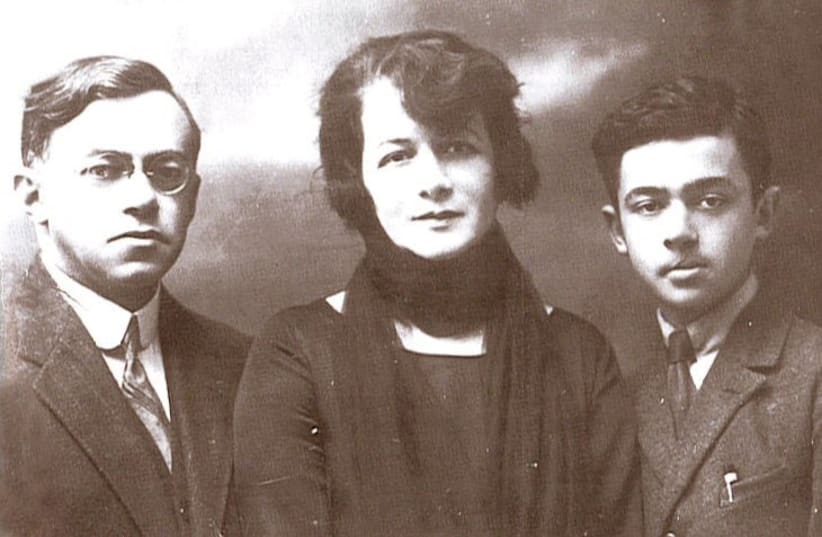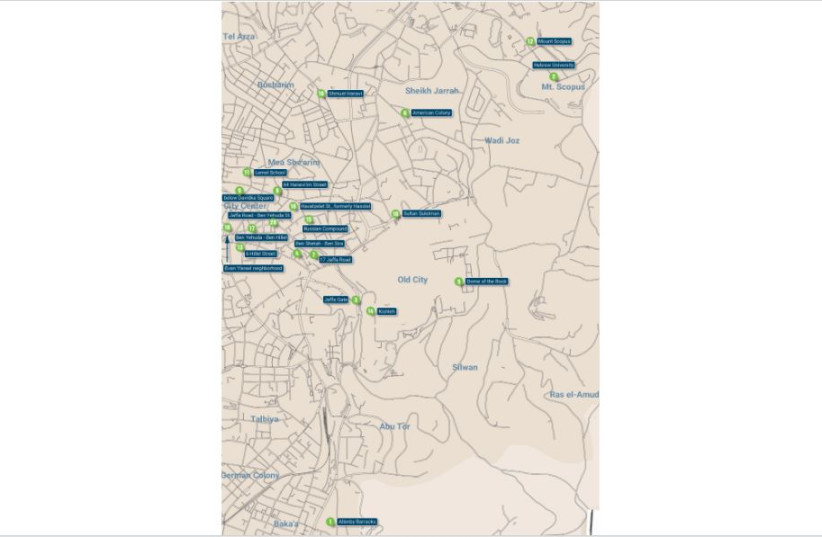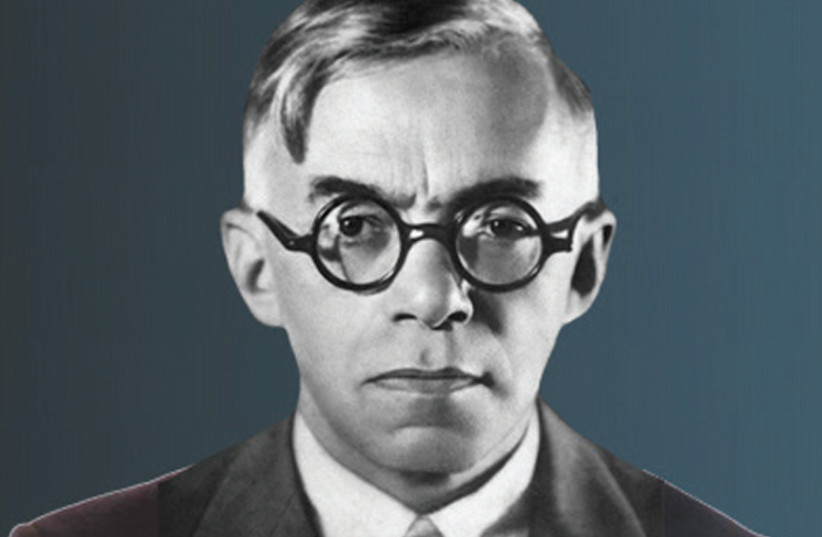Ze’ev (Vladimir) Jabotinsky visited or resided in Jerusalem during several all-too-brief periods of his short life.
Jabotinsky, a leader of prewar Russian Zionism, founder of the Jewish Legion of World War I as well as Jerusalem’s Hagana in 1920, member of the Zionist Executive, creator of the Revisionist wing of Zionism and “father” of the Irgun, highlighted Jerusalem in a few of his poems.
He was in the country at the end of 1908 for just a few months, as part of his Zionist promotion work in the Ottoman Empire, but his autobiography does not mention the city. Between March 1918 and July 1920, he was an officer in the Jewish Legion and then a member of the Zionist Commission, and lived in the city. He briefly visited the city in 1926.
In October 1928, he arrived, in his mind, as an immigrant. However, at the very end of December 1929, he left for a speaking tour in South Africa, and the British Mandate authorities, citing an “incendiary” speech he made in Tel Aviv, exploited his absence and banned him from returning.
In honor of his 82nd yahrzeit, I suggest a list of locations linked to his activities in Jerusalem from which one can create an itinerary for a walk in his footsteps.
Arrival in Jerusalem
JABOTINSKY ARRIVED in then-Palestine from Egypt in the last week of March 1918. Most of his fellow soldiers of the Jewish Legion, eventually to comprise three battalions of the Royal Fusiliers, arrived only in early June.
He visited Jerusalem once on Zionist business in April to confer with members of the Zionist Commission, headed by Chaim Weizmann.
By June 10, the troops were on the way to the front lines opposite the Ottoman and German forces between Shiloh and Abwein in the lower Samarian Hills.
Between June 20 and July 7, he was again in Jerusalem, possibly at the Allenby Barracks, Hebron Road (1), continuing the campaign to persuade local volunteers to enlist in the legion.
On July 24, 1918, he participated in the symbolic cornerstone-laying ceremony of the Hebrew University (2) at John Gray Hill’s Mount Scopus mansion. For the next two weeks he was invalidated with an infected knee after cutting it on barbed wire at Abwein.
The second half of August he was in Cairo and returned to Jerusalem in the second week of September. From September 13 he was in the battle for the Jordan River ford at Umm esh-Shert.
By the summer of 1919, he had been dismissed from the army for criticizing the political orientation of the military government, and in August his wife, Yohanna, and son, Eri, arrived from London to reunite in Jerusalem.
After a short stay at the Amdursky Hotel just inside Jaffa Gate (3), they began residence in the Levy Building located at the corner of today’s Shimon ben Shetah and Ben Sira streets off of Shlomzion Hamalka (4).
On one of their walks about the city, they ascended to the Temple Mount and managed to gain entrance to the Dome of the Rock (5).
Jabotinsky and his son even walked all the way to Motza one day.
After the great snowfall of February 15, Jabotinsky and his wife trudged to the American Colony (6) neighborhood to assist the Ettinger family. It was at this house, as commander of the Hagana in the city, that he was arrested for the illegal possession of arms on April 7, 1920.
Jabotinsky worked at the Zionist Commission office, rented from the Hughes Hotel, situated at the top floor at 17 Jaffa Street, one of the two Armenian Buildings (7). He contributed articles to the Haaretz newspaper, whose logo he helped create. Together with Gad Frumkin, he prepared a lecture series for the training of new lawyers. One of the lecturers was Yaakov De Haan. He was also a guest at Dr. Helene Kagan’s home at 64 Hanevi’im Street (8).
In late 1919, Jabotinsky was asked by Weizmann, who returned to the country in mid-October after a year’s absence, to assume responsibility for a self-defense unit for Jerusalem’s Jews. The anti-Zionist rhetoric of the Arabs was becoming more shrill and alarming. On Balfour Day, November 2, 1918, Jewish school pupils and adults had been assaulted by an Arab crowd protesting at Jaffa Gate and led by the city’s mayor. Already, in January 1919, Jabotinsky had written to his wife, “The Arabs draw encouragement from the fact that the British do not uphold their promises; the situation is bound to end up like Kishinev.”
“The Arabs draw encouragement from the fact that the British do not uphold their promises; the situation is bound to end up like Kishinev.”
Ze'ev Jabotinsky
On the evening of March 8, 1920, Jabotinsky addressed thousands of Jerusalemites who gathered in front of the Beit Ha’am, then located in the area between today’s Jaffa and Nevi’im streets just below Davidka Square, now a parking lot (9), commemorating Yosef Trumpeldor and his seven comrades who fell at the battle of Tel Hai. Trumpeldor had assisted Jabotinsky in February 1915, when both were in Egypt, to persuade Gen. John G. Maxwell, commander of British forces in Egypt, to raise what became the Zion Mule Corps which later that year fought at Gallipoli with distinction.
At the beginning of 1920, two demonstrations of Arabs protesting Zionism and promoting the reunification of Palestine with Syria under King Faisal, the former leader of the Great Arab Revolt aided by T.E. Lawrence, took place. The first, on February 27, was a march along today’s Sultan Suleiman Street (10) and the second was on March 8 at the Jaffa Gate (3).
Jabotinsky had by then been holding drilling exercises and strategy instruction drilling daily behind the Lemel School (11) on Yeshayahu Street. On March 27, he marched 600 men from the school to the slopes of Mount Scopus (12) to perform field maneuvers in clear view of the British and the Arabs.
Nevertheless, the Arabs launched their violent attacks on April 4 during the Nabi Musa festivities. Jabotinsky hurried to the Bachelors’ Dormitory of the Bezalel School students, still standing in the yard behind 6 Hillel Street (13), to assign them and others to planned positions across the city.
Jabotinsky was arrested at his apartment on April 7, briefly detained at the Kishle (14), then held at the Central Prison in the Russian Compound (15) for eight days as Prisoner No. 127, and after a brief military trial was incarcerated with another 19 Hagana volunteers in Acre Prison. They were released some three months later, and Jabotinsky subsequently left for England, disappointed with the policies of the British Military Administration and the Zionist Commission as well.
In January 1923, he resigned from his membership in the World Zionist Executive.
ON OCTOBER 3, 1926, Jabotinsky returned to Mandate Palestine, arriving at Jaffa Port, intent on mobilizing for his recently founded opposition Revisionist Party. His public appearance in Jerusalem was on Tuesday, October 19, at the Maccabi sports field, today, the site of Pomerantz House off of Magen Ha’elef Street near Eretz Hafetz Street in the Shmuel Hanavi neighborhood (16), where he delivered an address beginning just after 4:30 p.m.
Incidentally, the Hebrew University refused to permit him to appear on its grounds, and he protested to Norman Bentwich that he was being boycotted.
The Palestine Bulletin reported that “An extraordinary spirit of enthusiasm pervaded the Jerusalem public yesterday afternoon when Vladimir Jabotinsky... delivered a striking address on the situation in Palestine. All classes of the Jewish population were represented... six thousand people forming an audience that rose... and accorded him a rousing ovation.”
Jabotinsky, writing to his wife in Paris, claimed only 4,000 were present.
Later that evening, at 10 p.m., a banquet was given in his honor in the New Central Hotel. The newspaper described his speech as “a brilliant piece of oratory, comprising a personal confession of the speaker’s attitude in Zionism and a deep analysis of the situation in Zionism and Jewish character.”
The hotel, belonging to the Amdursky family, was located at the corner of today’s Ben-Yehuda and Ben-Hillel streets (17).
On November 3 he was back in Jerusalem briefly for two days to obtain visas from various consulates, and on November 16 sailed back to Europe.
HAVING RETURNED to Jerusalem for what he hoped would be for good, on October 10, 1928, he assumed the editorship of the Do’ar Hayom daily at the end of December, whose editorial offices were at the bottom of Hasolel Street (18), and lived in the Even Yisrael neighborhood (19).
He shared rooms with an Orthodox man, and he recalled that during that time, he strictly kept kashrut and Shabbat restrictions in respect of his flatmate.
For income, he was first manager, then vice president, of the board of directors of the Judea Insurance Company branch in Palestine, whose offices were on Jaffa Road off Ben-Yehuda Street (20). His post office box number was 828.
After some six weeks abroad in Vienna, Paris and London, he was back in Jerusalem by the beginning of February 1929.
On July 22, he was on a boat, traveling, like many other Zionist personalities in Palestine, to the Zionist Congress in Zurich, and was not in the country during the August riots. He stayed in Paris until returning to Palestine in the first week of December.
On the 25th of that month, he sailed for Egypt, and never again set foot in the Land of Israel, as the British canceled his residency rights. ❖
With thanks to Yair Assaf-Shapira for creating the map.


